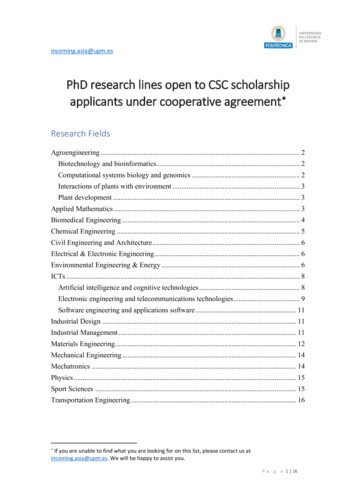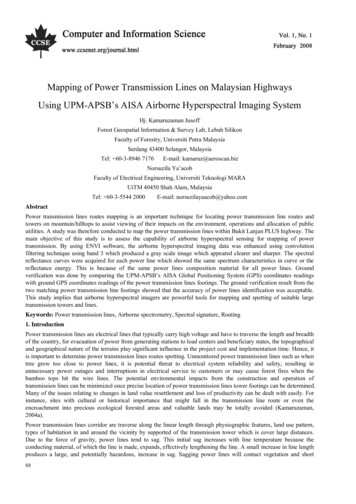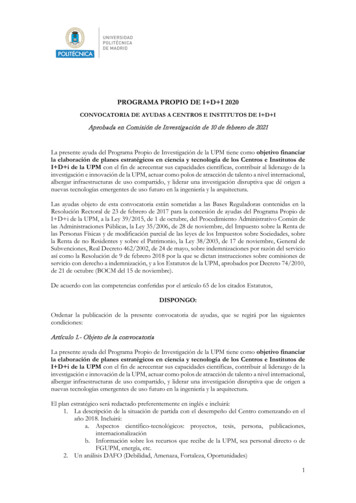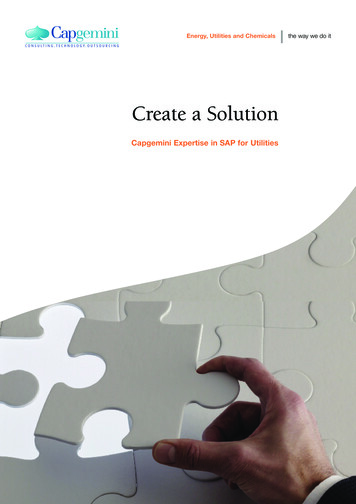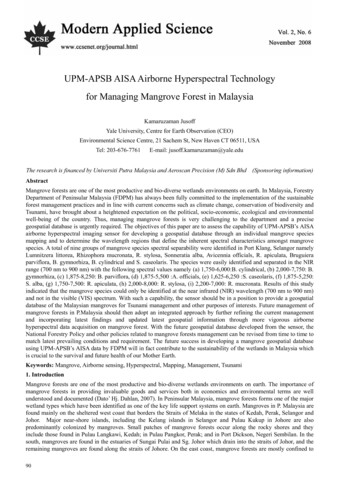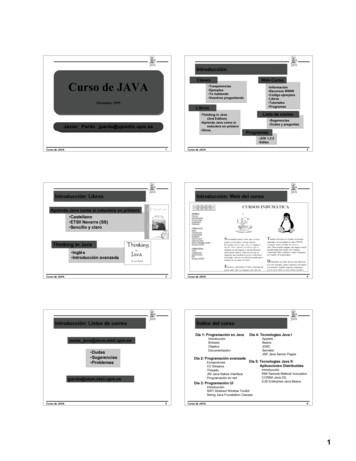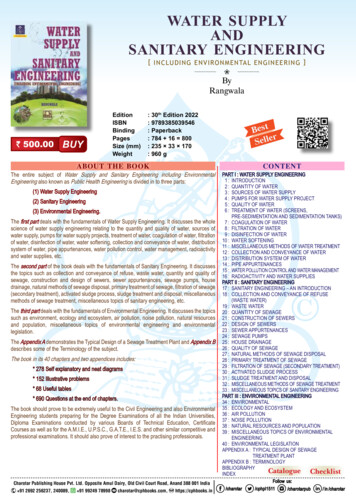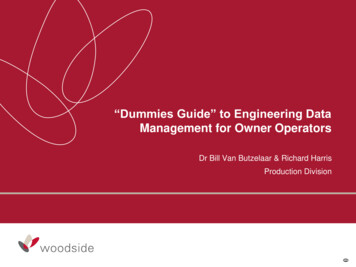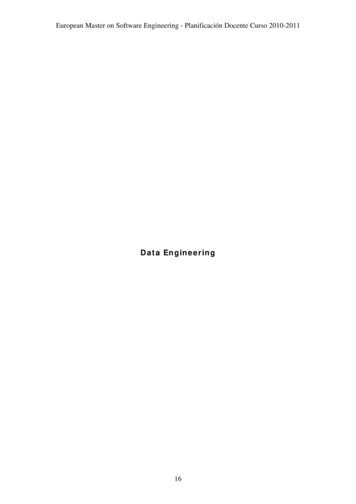
Transcription
European Master on Software Engineering - Planificación Docente Curso 2010-2011Data Engineering16
Data . DescriptionGradeEUROPEAN MASTER ON SOFTWARE ENGINEERINGModuleAdvanced Software Engineering AspectsAreaSubjectData engineeringTypeOptionalECTS nknownAcademic year2010/2011Term1st and 3rd termLanguageEnglishWeb sitehttp://pegaso.ls.fi.upm.es/idatos
2. FacultyNAME and SURNAMEOFFICEemailÓscar Marbán GallegoD-4302omarban@fi.upm.esErnestina Menasalvas RuizD-4303emenasalvas@fi.upm.es3. Prior knowledge required to take the subjectPassed subjectsOther requiredlearning outcomesDesign of relational databasesImplementation of relational databasesSQL language
4. Learning goalsSUBJECT-SPECIFIC COMPETENCES AND PROFICIENCY LEVELCodeSC13SC14CompetenceLevelTo have a vision of the different specific and emergentaspects of the Software Engineering, and to go further insome of them.STo understand what nowadays software engineeringprocedures can and cannot reach, their limitations and theirpossible future sion (C),application(A),andanalysisandsynthesis(S)
SUBJECT LEARNING OUTCOMESCodeLearning uture.SC13, SC14Proficiencylevel3-4
5. Subject assessment systemACHIEVEMENT INDICATORSRefRelated toLRIndicatorI1Design of a Data WarehouseLR1I2Knowledge of the architecture of a Data WarehouseLR1I3Implements a Data WarehouseLR1I4Obtains implici knowlegde from dataLR1I5Knowlede of Data Mining techniquesLR1I6Knowledge of the Data Mining processLR1I7Handle Data Mining techniquesLR1I8Handles Data Mining toolsLR1CONTINUOUS ASSESSMENTTimePlaceWeightingradeProject 1 (4 assignements)Weeks 1-8Home40%Project 2Weeks 8 16Home40%ExamWeek 16Class20%Brief description of assessable activitiesTotal: 100%
GRADING CRITERIAThecourseiscomposedbytwomainparts:1. DataWarehouse2. ws.1. ndthevaluesofitcanbeseeninthetable.2. ecoursethefollowingrequirementsareneeded:1. toobtain50/100pointsatleast2. entsandprojects3. ationof30%fromitsfinalvalue(seetable)4. hefollowingrequirementsareneeded:1. tofthecourse.2. Thevaluesofeachpartareasfollows:a. Part1:50%b. Part2:50%
GRADING CRITERIA3. Obtain50/100pointsintheglobalvalue
6. Contents and learning activitiesSPECIFIC CONTENTSUnit / Topic /ChapterChapter 1:INTRODUCTIONSection1.1 Business Intelligence Introduction2.1 Data warehouse architectureChapter 2: DatawarehouseChapter 3: DataMiningRelatedindicatorsI2, I6I22.2 ETL ToolsI1, I22.3 Multidimensional modelI1, I32.4 Data warehouse design methodologiesI1, I32.5 Data warehouse toolsI1, I32.6 OLAP toolsI43.1 KDD processI63.2 Data mining techniquesI73.3 Data mining toolsI83.4 Data mining methodologiesI63.5 CRISP-DMI6
7. Brief description of organizational modalities andteaching methodsTEACHING ORGANIZATIONScenarioOrganizational ModalityPurposeTheory ClassesTalk to studentsSeminars/WorkshopsConstruct knowledgethrough studentinteraction and activityPractical ClassesShow students what todoPlacementsRound out studenttraining in a professionalsettingPersonal TutoringGive studentspersonalized attentionGroup WorkGet students to learnfrom each otherIndependent WorkDevelop self-learningability
TEACHING METHODSMethodPurposeExplanation/LectureTransfer informationand activate studentcognitive processesKnown as explanation, this teaching method involves the “presentation of a logically structured topic withthe aim of providing information organized according to criteria suited for the purpose”. This methodology,also known as lecture, mainly focuses on the verbal exposition by the teacher of contents on the subjectunder study. The term master class is often used to refer to a special type of lecture taught by a professoron special occasionsCase StudiesLearning by analyzingreal or simulated casestudiesIntensive and exhaustive analysis of a real fact, problem or event for the purpose of understanding,interpreting or solving the problem, generating hypotheses, comparing data, thinking, learning or diagnosisand, sometimes, training in possible alternative problem-solving procedures.Exercises andProblem SolvingExercise, test andpractice priorknowledgeProblem-BasedLearning (PBL)Develop activelearning throughproblem solvingTeaching and learning method whose starting point is a problem, designed by the teacher, that the studenthas to solve to develop a number of previously defined competences.Project-OrientedLearning (POL)Complete a problemsolving projectapplying acquiredskills and knowledgeTeaching and learning method where have a set time to develop a project to solve a problem or perform atask by planning, designing and completing a series of activities. The whole thing is based on developingand applying what they have learned and making effective use of resources.CooperativeLearningDevelop active andmeaningful learningthrough cooperationInteractive approach to the organization of classroom work where students are responsible for their ownand their peers’ learning as part of a co-responsibility strategy for achieving group goals and incentives.Learning ContractDevelop independentlearningAn agreement between the teacher and student on the achievement of learning outcomes through anindependent work proposal, supervised by the teacher, and to be accomplished within a set period. Theessential points of a learning contract are that it is a written agreement, stating required work and reward,requiring personal involvement and having a time frame for accomplishment.Situations where students are asked to develop the suitable or correct solutions by exercising routines,applying formulae or running algorithms, applying information processing procedures and interpreting theresults. It is often used to supplement lectures.This is both one of a number of methods for use and an overall teaching approach, or philosophy.
BRIEF DESCRIPTION OF THE ORGANIZATIONAL MODALITIES ANDTEACHING METHODSTHEORY CLASSESTheoretical classes will proceed participatively, with certainones requiring a previous study by the student of somebibliographyPROBLEM-SOLVINGCLASSESSome classes will be dedicated to problem solving andmodelling in the classroom to have a discussion on the issuesmodeled at the end of the classroom.PRACTICAL WORKINDIVIDUAL WORKIndividual works will be announced in classroom for thecourse.GROUP WORKThe main learning activity in the course will consist on a teamproject in teams of 4 students, applying practically theconcepts discussed in the classroom to the project.PERSONALTUTORINGThe classes dedicated to follow-up of team projects will servea group tutoring, while other assignments will be tutored atthe student request.11
8. Teaching resourcesTEACHINGRESOURCESBuilding the data warehouse. W. H. immnon. 1996. WilleyManaging the Data Warehouse. W. H. Immon. 1997. WilleyBuilding the operational Data Store. W. H. Immon. 1999. WilleyExploration Datawarehouse. W. Immon. 2000. WilleyRECOMMENDEDREADINGImproving Data Warehouse and Business Information Quality.Methods for reducing cost and increasing profits. L. English.1999 WilleyData Mining Techniques for Marketing, Sales, and Customersupport. Michael J. A. Berry and Gordon Linoff. 1997. WilleyData Mining Solutions: Methods for solving Real-WorldProblems. C. Westphal, T. Blaxton. 1998. WilleyMastering Data mining . The art and science of Customerrelationship management. M. Berry, G. Linoff. 2000. WilleyThe data warehouse lifecycle toolkit. R. Kimball. 2000. WilleyWEB RESOURCESEQUIPMENTSubject web site (http://pegaso.ls.fi.upm.es)RoomGroup work room12
9. Subject scheduleWeekClassroom activitiesWeek 1(6 hours)1.1 Business Intelligenceintroduction (2 hours)Independent work (2 hours)Group work (2hours)Week 2(7 hours)2.1 Data warehousearchitecture (2 hours)Independent work (2 hours)Group work (3hours)Week 3(7 hours)2.2 ETL Tools (1 hours)Independent work (2 hours)Group work (2hours)Week 4(7 hours)2.3 Multidimensional model(2 hours)Independent work (2 hours)Group work (3hours)Week 4(7 hours)2.3 Multidimensional model(2 hours)Independent work (2 hours)Group work (3hours)Week 6(7 hours)2.5 Data warehouse tools(1 hours)Independent work (2 hours)Group work (2hours)Presentation (1 hora)Week 7(7 hours)2.6 OLAP Tools (1 hours)Independent work (2 hours)Group work (2hours)Presentation (1 hora)Week 8(7 hours)2.4 Data warehousedesign methodologies (1hours)Independent work (2 hours)Group work (2hours)Presentation (1 hora)LabactivitiesIndividual work13Group workAssessmentactivitiesPresentation (1 hours)Others
Week 9(6 hours)3.1 KDD process (2 hours)Independent work (2 hours)Group work (2hours)Week 10(7 hours)3.1 KDD process (2 hours)Independent work (2 hours)Group work (3hours)Week 11(7 hours)3.2 Data mining techniques(2 hours)Independent work (2 hours)Group work (3hours)Week 12(7 hours)3.2 Data mining techniques(1 hours)Independent work (2 hours)Group work (2hours)Presentation (1 hora)Week 13(7 hours)3.3 Data mining tools (1hours)Independent work (2 hours)Group work (2hours)Presentation (1 hora)Week 14(7 hours)3.4 Data miningmethodologies (2 hours)Independent work (2 hours)Group work (3hours)Week 15(6 hours)3.5 CRISP-DM (2 hours)Independent work (2 hours)Group work (2hours)Week 16(7 hours)3.5 CRISP-DM (1 hours)Independent work (2 hours)Group work (3hours)Week 17(2 hours)Final exam (2 inhoursPresentation (1 hora)14
2.1 Data warehouse architecture I2 2.2 ETL Tools I1, I2 2.3 Multidimensional model I1, I3 2.4 Data warehouse design methodologies I1, I3 2.5 Data warehouse tools I1, I3 Chapter 2: Data warehouse 2.6 OLAP tools I4 3.1 KDD process I6 3.2 Data mining techniques I7 3.3 Data mining tools I8 3.4 Data mining methodologies I6 Chapter 3: Data

